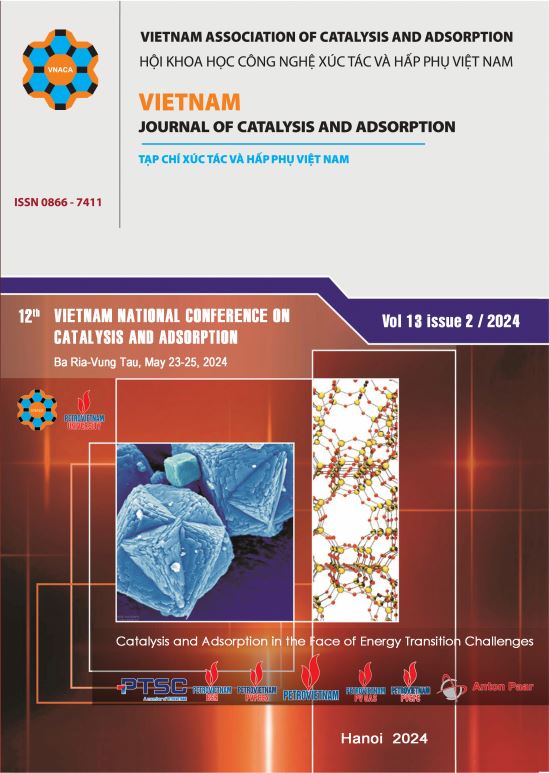Electrochemical modification of glassy carbon electrode (GCE) with cobalt ferrite/ reduced graphene oxide composite material comprising polyaniline for dissolved oxygen analysis in water
DOI:
https://doi.org/10.62239/jca.2024.023Keywords:
Glassy carbon electrode , polyaniline, polymer, PANI, GCE/PANi, GCE/PANi/CoFe2O4/ rGOAbstract
The study focuses on the enhancement of glassy carbon electrode (GCE) performance through electrochemical modification with a composite material comprising polyaniline (PANi) conducting polymer and CoFe2O4/reduced graphene oxide (CF/rGO) for the analysis of dissolved oxygen in water. Characterization methods, including Fourier-transform infrared spectroscopy (FT-IR) and Scanning Electron Microscope (SEM), were employed to elucidate the chemical bonding of functional groups within the PANi membrane and modified PANi on the surface of the GCE electrodes as well as examine the surface morphology. Electrochemical studies were conducted to evaluate the electrochemical activity of the modified electrodes, GCE/PANi and GCE/PANi/CF/rGO. Electrochemical studies were conducted to evaluate the electrochemical activity of the modified electrodes, GCE/PANi and GCE/PANi/CF/rGO. Notably, the electrochemically active surface area of the modified electrodes significantly increased, from 0,0756 cm2 (GCE), 0,1106 cm2 (GCE/PANi) to 0,1774 cm2 (GCE/PANi/CF/rGO), in addition the peak current intensity (Ip) on the modified electrodes GCE/PANi and GCE/PANi/CF/rGO also increased compared to the unmodified electrode (GCE), Ip increased from 0,0767.10-3 (A) to 0,18 x 10-3 (A), resulting in an increased ability to sense dissolved oxygen in water.
Downloads
References
Nguyen Thi Vuong Hoan, Nguyen Ngoc Minh, Nguyen Thi Hong Trang, Le Thi Thanh Thuy, Cao Van Hoang, Tran Xuan Mau, Ho Xuan Anh Vu, Phan Thi Kim Thu, Nguyen Hai Phong, Dinh Quang Khieu, Journal of Nanomaterials, 2020 (2020) 9797509. https://doi.org/10.1155/2020/9797509
Lu D., Zhang Y., Wang L., Lin S., Wang C., Chen X., Talanta, 88 (2012) 181-186. https://doi.org/10.1016/j.talanta.2011.10.029
Behzad Rezaei, Sajjad Damiri, Electroanalysis, 21 (2009) 1577-1586. https://doi.org/10.1002/elan.200804571
Nguyễn Lê Huy, Nguyễn Tuấn Dung, Nguyễn Hải Bình, Trần Đại Lâm, Tạp chí Hóa học, 49 (2011) 357-360.
Phan Thi Kim Thu, Nguyen Duy Trinh, Nguyen Thi Vuong Hoan, Dang Xuan Du, Tran Xuan Mau, Vo Huu Trung, J Mater Sci: Mater Electron 30 (2019) 17245–17261. https://doi.org/10.1007/s10854-019-02072-8
Xianfeng Du, Youlong Xu, Lilong Xiong, Yang Bai, Jianbo Zhu, Shengchun Mao, J. Appl. Polym. Sci., 131 (2014) p.40827. https://doi.org/10.1002/app.40827
G. Umadevi, V. Ponnusamy, M. Paramsivam and A.Elango, Electrochimica Acta, 26 (2008) 461-467. https://doi.org/ 10.4152/pea.200806461
M. Piotr Wojciechowski, Wiktor Zierkiewicz, Danuta Michalska, Pavel Hobza, J. Chem. Phys. 118 (2003) 10900-10911. https://doi.org/10.1063/1.1574788
Shim, Y. B.; Stilwell, D. E.; Park, S. M., Electroanalysis, 3 (1991) 31-36. https://doi.org/10.1002/elan.1140030106
Mei, J. and L. Zhang, Electrochimica Acta, 173 (2015) 338-344. https://doi.org/10.1016/j.electacta.2015.05.064
Nguyễn Thị Vương Hoàn và cộng sự, Nghiên cứu tổng hợp nanocomposite MFe2O4 (M = Fe, Co, Ni)/ graphen và vật liệu trên cơ sở graphen biến tính ứng dụng trong xử lý môi trường và cảm biến điện hóa, 2020, B2019-DQN-562-03.
Thien Dien To, Tung Son Vinh Nguyen, Tin Chanh Duc Doan, Chien Mau Dang, IOSR Journal of Engineering (IOSRJEN), 5 (2015) 14-22.
Staudenmaier L., Berichte der deutschen chemischen Gesellschaft, 31 (1988) 1481-1487. https://doi.org/10.1002/cber.18980310237
Downloads
Published
Issue
Section
How to Cite
Share
Funding data
-
Ministry of Science and Technology
Grant numbers ĐTĐLCN.44/22











